 Image search results - "yamato" Image search results - "yamato" |

Kanagawa Prefecture's largest Awa Odori is held annually during the last weekend in July in this city of Yamato. Preview event near Yamato Station.
|
|
|

Pre-festival event held in the afternoon, Yamato Awa Odori
|
|
|

Yamato Station
|
|

Balloons, souvenirs and trinkets sold near the train station.
|
|
|

Main drag and shopping arcade called Yamato Chuo-dori大和中央通り
|
|

Spectators wait for the parade to begin.
|
|

The festival/parade starts before dark.
|
|
|
|
|
|
|
|
|
|
|
|
|
|

Mime act depicting a kite
|
|

A fool's dance.
|
|

End of the parade route.
|
|
|
|
|

Yamato Awa OdoriHeld in late July, Kanagawa Pref.
|
|

Chidori-ren troupeちどり連
|
|

ちどり連
|
|

Yamato Awa Odori
|
|
|
|
|
|
|

Woman drummer
|
|
|
|
|
|

Chidori-ren was my favorite of all.ちどり連
|
|
|
|

Their dance moves were outstanding.
|
|

They were in great physical condition.
|
|

The men in Chidori-ren.
|
|
|
|
|
|
|
|

They are actually members of the Maritime Self-Defense Force based in Atsugi.
|
|

I kept chasing them along the parade route and got these great shots.
|
|
|
|
|
|
|
|

Chidori-ren ちどり連
|
|

Yamato Awa Odori
|
|
|
|

ちどり連
|
|

Chidori-ren at Yamato Awa Odori
|
|
|
|
|
|
|
|
|
|
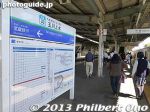
Higashi-Yamato Minami Park is a large park with greenery and sports facilities. One interesting edifice is the former Hitachi Aircraft Transformer Substation pockmarked with bullet holes from World War II. The park was formerly the US Air Force's Yamato Air Station. Before that from 1938 and during World War II, it was the site of a military aircraft engine factory. Near Tamagawa Josui Station on the Seibu Haijima Line.
|
|
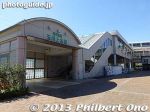
Tamagawa Josui Station
|
|
|
|
|
|
|
|
|
|
|
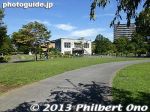
Former Hitachi Aircraft Transformer Substation pockmarked with bullet holes from World War II. 旧日立航空機立川工場変電所
|
|
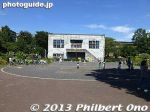
From 1938 and during World War II, Higashi-Yamato Minami Park was the site of a military aircraft engine factory. This transfomer substation supplied power to
|
|
|
|
|
|
|
|
|
|
|
|
|
|
|
|
|
|
|
|
|
|
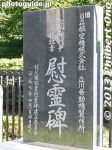
Memorial for the workers at the Hitachi Aircraft engine factory who died from aerial bombings by the US during World War II.
|
|
|
|
|
|
|
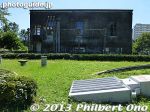
Back of former Hitachi Aircraft Transformer Substation.
|
|
|
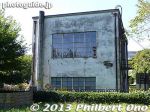
Side of former Hitachi Aircraft Transformer Substation.
|
|
|
|
|
|
|
|
|
|
|
|
|
|
|
|
|

Bicycles near Tamagawa-Jōsui Station.
|
|

Bicycles near Tamagawa-Jōsui Station.
|
|

Bicycles near Tamagawa-Jōsui Station.
|
|
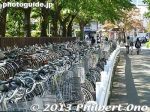
Bicycles near Tamagawa-Jōsui Station on the Seibu Haijima Line.
|
|
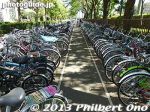
Bicycles near Tamagawa-Jōsui Station on the Seibu Haijima Line.
|
|
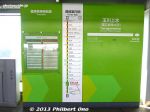
Tamagawa Josui Station on Tama Toshi Monorail Line.
|
|
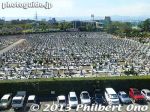
Cemetery seen from Tama Toshi Monorail Line near Tamagawa-Jōsui Station.
|
|
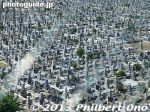
Cemetery
|
|
|
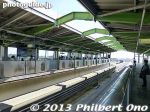
Tama Toshi Monorail Line platform.
|
|
|

Tama Toshi Monorail Line
|
|
|
|
|
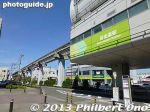
Sakura Kaido Station, got off here to walk around.
|
|
|
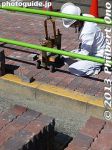
Setting/installing cobblestones.
|
|
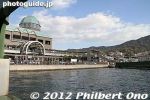
Kure Port in Hiroshima Prefecture. We arrived from Etajima island across the Seto Inland Sea. Kure is also a short train ride from Hiroshima Station.
|
|
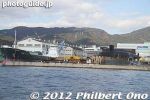
From the boat, we could see the dock where the Battleship Yamato was built in Kure, Hiroshima. "Kure" is pronounced "Kuray" not like the word "cure."
|
|
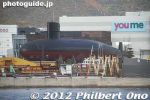
We could also see the submarine museum at the JMSDF Kure Museum adjacent to the Yamato Museum.
|
|

Kure is a major shipbuilding town.
|
|

Back of the Yamato Museum facing Kure Port.
|
|

Kure Port dock.
|
|
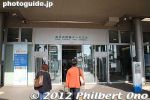
Entering Kure Port terminal.
|
|

Welcome to Kure.
|
|
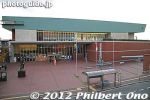
Yamato Museum's official name is Kure Maritime Museum. Although the 1/10 scale model of Battleship Yamato is the main attraction, it also has other exhibits explaining Kure's maritime history.
|
|

The Yamato Museum is open 9 am to 6 pm (enter by 5:30 pm). Admission is 500 yen for adults, 300 yen for high schoolers, and 200 yen for kids. Battleship Yamato was built in Kure.
|
|
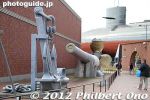
Outside the museum, a battleship gun and anchor are displayed.
|
|
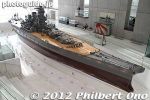
Yamato Museum's main attraction is this large scale model of Battleship Yamato. You can walk around it. This area of the museum is called Yamato Hiroba.
|
|
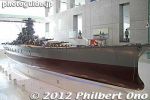
The scale model of the battleship is 26.3 meters long. It has been reconstructed as accurately as possible based on photographs and exploration of the wreck.
|
|
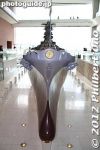
Battleship Yamato has an Imperial chrysanthemum crest on the bow. This was one of the things which helped to identify the wreck on the sea bottom.
|
|
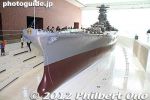
Battleship Yamato was commissioned a week after the Pearl Harbor attack in Dec. 1941. It was Japan's most powerful battleship and now legendary. It turned out to be great waste since the big guns were hardly used and it was sunk 4 years later.
|
|
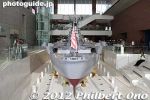
"Yamato" is another name for Japan, and so it is a very revered and prestigious name for any ship. Many movies, anime, etc., have been based on Battleship Yamato which retains a strong cultural influence in Japan.
|
|
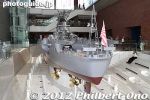
The Yamato's final mission was suicidal. It was ordered to go to Okinawa in April 1945 and beach herself offshore so it wouldn't sink. While beached, it would fire its guns at the enemy on Okinawa.
|
|
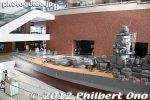
On her way to Okinawa, the Yamato was spotted by US submarines and aircraft and sunk by American carrier-based bombers and torpedo bombers on April 7, 1945.
|
|
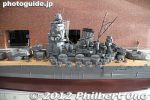
Since the Yamato was built in secrecy, there are very few clear photos of the ship.
|
|
|
|
|
|
|
|
|
|
|
|
|
|
|
|
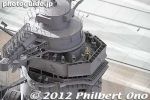
The model even has little human figures.
|
|
|
|
|
|
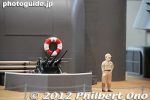
All aboard!
|
|
|
|
|
|
|
|
|
|
|
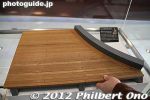
Sample wood paneling used for the model deck.
|
|
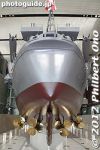
Propellers of Battleship Yamato.
|
|
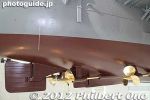
Rudder and propellers of Battleship Yamato.
|
|
|
|
|
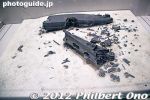
One exhibition room has a model of the Battleship Yamato wreck.
|
|

Admiral Isoroku Yamamoto's connection with Kure. On the bridge of the Yamato, he commanded the fleet at the Battle of Midway.
|
|
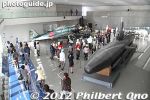
Another large exhibition room had a Japanese Zero fighter plane, kaiten manned torpedo, and midget submarine.
|
|
|

Midget submarine.
|
|
|
|
|
|
|
|
|
|
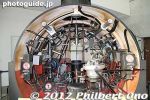
Midget submarine cockpit.
|
|
|
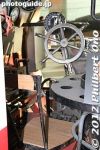
Midget submarine cockpit.
|
|

About midget submarines.
|
|
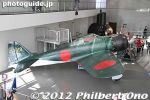
Japanese Zero fighter.
|
|
|

Japanese Zero fighter cockpit.
|
|
|
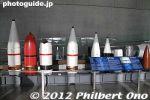
Gun shells
|
|
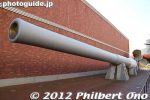
41-cm diameter gun from Battleship Mutsu, outside the Yamato Museum. Until the Yamato was built, the Mutsu was Japan's largest battleship.
|
|

Battleship Mutsu plaque. After seeing the Yamato Museum, be sure to cross the street over to the submarine museum called the JMSDF (Japan Maritime Self-Defense Force) Kure Museum.
|
|
|
|
|